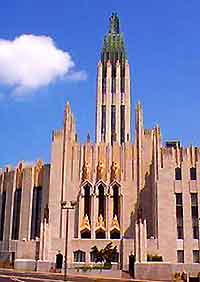Tulsa History Facts and Timeline
(Tulsa, Oklahoma - OK, USA)

The earliest recorded settlement in the area of modern day Tulsa was in 1836. Five different Native Indian tribes were relocated to the Green Country of Oklahoma in the 1830s, after the passing of the Indian Removal Act of 1830.
This act forced Native Indian people to move from the lands east of the Mississippi River. The Tulsa area was originally part of Indian Territory, which was created to accommodate the relocated Indians.
The Creek Council Oak Tree, which was the first settlement of the Tulsa community in the 1830s, still stands proudly today. It is found at the junction of Cheyenne Avenue and 18th Street. The first church, the first council meeting and the earliest community hall were all located or held here.
Railroad Influences and History
The area settled by the five Native Indian tribes developed slowly, finally becoming an incorporated city in 1898. Prior to this date, the first railway connection, known as the Frisco, began to serve Tulsa in 1882, linking
San Francisco with
St. Louis. The cattle industry, which heavily relied on the rail link, became the first significant industry.
Oil Industry Boom
Tulsa transformed from a small cattle town in the 19th century to a booming 20th-century oil city in the space of a few years. In 1901, the city founded its first oil well, known as Sue Bland No. 1. Just four years later, the large Glenn Pool oil site was established just outside the city center. The oil industry attracted thousands of people, all looking to strike it rich or develop businesses. By 1930, more than 140,000 residents inhabited Tulsa.
Greenwood Race Riots
African-American neighborhoods developed along with the rest of the city's districts, with the biggest and most successful being the district of Greenwood. However, large-scale riots, regarded as the worst in the US, blackened the history of the neighborhood in 1921. More than 800 people were wounded, US$2 million dollars damage was created and about three dozen people were killed in the riots.
This significant part of Tulsa history has been recorded at the Greenwood Cultural Center. Visitors will find that this establishment highlights the influence that the race riots had on the city in the 1920s.
Route 66
In 1925, the father of Route 66, Cyrus Avery, chose Tulsa as the US Highway 66 Association headquarters. When the highway was completed, Tulsa became part of American navigation history and began welcoming thousands of extra visitors each year. The famous Meadow Gold sign still stands along the old Route 66 highway today.
20th-Century Oil Bust
At one stage in its history, Tulsa was nicknamed the 'Oil Capital of the World'. However, the 1982 recession throughout the United States led to the diminishing of the city's oil industry. The local economy was seriously weakened as a result, but by the early 1990s it had fully recovered.
Tulsa lost its oil capital nickname to
Houston and soon began to develop its economy using resources not related to the oil industry, such as tourism.
 The earliest recorded settlement in the area of modern day Tulsa was in 1836. Five different Native Indian tribes were relocated to the Green Country of Oklahoma in the 1830s, after the passing of the Indian Removal Act of 1830.
The earliest recorded settlement in the area of modern day Tulsa was in 1836. Five different Native Indian tribes were relocated to the Green Country of Oklahoma in the 1830s, after the passing of the Indian Removal Act of 1830.